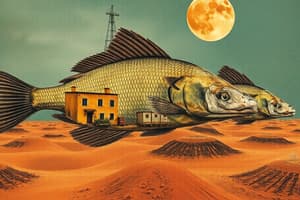Podcast
Questions and Answers
What is an ecosystem?
What is an ecosystem?
An area in which plants and animals live in balance with their environment and are inter-linked with it. (It does not change unless external factors influence it.)
List the reasons for the destruction of rainforests.
List the reasons for the destruction of rainforests.
Mining, population growth, agriculture (land is cleared for consumer goods), logging (trees cut down), plantations, road building.
What is desertification?
What is desertification?
Turning land into desert, it is a process of land degradation, mainly in arid and semi-arid lands where the rainfall is unreliable (or because of human activity).
Name the global areas that are at serious risk of desertification.
Name the global areas that are at serious risk of desertification.
What are the main causes of desertification?
What are the main causes of desertification?
Where do Tropical Cyclones primarily form?
Where do Tropical Cyclones primarily form?
Match the different names of tropical cyclones with their locations.
Match the different names of tropical cyclones with their locations.
What is the minimum sea surface temperature required for cyclones to form?
What is the minimum sea surface temperature required for cyclones to form?
What is the calm center of a tropical cyclone called?
What is the calm center of a tropical cyclone called?
What is the Saffir-Simpson Hurricane Wind Scale used for?
What is the Saffir-Simpson Hurricane Wind Scale used for?
What are the impacts and hazards of tropical cyclones?
What are the impacts and hazards of tropical cyclones?
Flashcards
Ecosystem
Ecosystem
An area where plants and animals live inter-connected and in balance with their environment. Stability depends on external factors.
Desertification
Desertification
Turning land into desert, mainly in dry areas with unreliable rainfall, often due to human activity.
Main causes of desertification
Main causes of desertification
Climate change, decreased rainfall, overcultivation, soil erosion, deforestation, and overgrazing
Reasons for rainforest destruction
Reasons for rainforest destruction
Signup and view all the flashcards
Tropical Cyclone Formation Zones
Tropical Cyclone Formation Zones
Signup and view all the flashcards
Tropical Cyclone Movement
Tropical Cyclone Movement
Signup and view all the flashcards
Main impact of Tropical Cyclones on Landfall
Main impact of Tropical Cyclones on Landfall
Signup and view all the flashcards
Tropical Cyclone Intensity
Tropical Cyclone Intensity
Signup and view all the flashcards
Wind Damage (Tropical Cyclones)
Wind Damage (Tropical Cyclones)
Signup and view all the flashcards
Inland Flooding (Tropical Cyclones)
Inland Flooding (Tropical Cyclones)
Signup and view all the flashcards
Study Notes
- Geography analyses the Earth’s physical environment and human populations.
Ecosystem
- An ecosystem is where animals and plants live interlinked in balance with their environment.
- Unless external factors influence it, it does not change.
Destruction of rainforests
- Mining
- Population growth
- Agriculture (land cleared for consumer goods)
- Logging (trees cut down)
- Plantations
- Road building
Desertification
- Desertification is the process of land degradation that turns land into the desert.
- It occurs mainly in arid and semi-arid lands where rainfall is unreliable or because of human activity.
- Regions at serious risk of desertification:
- The Sahel Region (Africa)
- Southern Africa
- China
- India
- Australia
- Argentina
- Drylands in Brazil
- Mexico
- North America
- Main Causes Include:
- Climate change
- A decrease in rainfall
- Effects of global warming
- High birth rates and immigration leading to overcultivation, soil erosion, and deforestation
- People seeking fuelwood
- Overgrazing in the Sahel
- When drought hit, too many animals stripped away grass
- Overgrazing near water sources worsened the problem, turning land into the desert.
- These events increase the vulnerability of local people to drought, food shortages, and the longer-term risk to their traditional way of life.
Tropical Cyclones
- Primarily form in tropical and subtropical regions with warm ocean waters.
- Other names for Tropical Cyclones include:
- Hurricanes in North and Central America
- Typhoons in the Northwest Pacific Ocean near China and Japan.
- Cyclones in the Indian Ocean and Australia
- Willy-Willy in Australia
- Cyclones require warm sea surface temperatures of at least 80°F(27°C).
- Regions include:
- The Caribbean
- Parts of Asia (notably the Philippines and Japan)
- Australia
- Coastlines of North America and South America
- Tropical cyclone activity is influenced by seasons, typically escalating during warmer months.
- The Atlantic hurricane season runs from June to November.
- Characteristics:
- A calm center called the eye
- The eyewall surrounds the eye with strong winds and heavy rainfall
- Tropical Cyclones are categorized using the Saffir-Simpson Hurricane Wind Scale
- Ranges from Category 1 (sustained winds of 74-95mph) to Category 5 (sustained winds over 157mph).
- The higher the category, the greater the potential damage.
- Wind speed is fierce, often exceeding 74mph, and heavy rainfall accompanies it, leading to flooding and other hazards.
- Cyclones typically travel westward and may veer towards the poles influenced by prevailing wind patterns.
- Including the Coriolis effect, helps them to gain strength through rotation.
- Storm surges elevate sea levels, causing flooding during landfall.
- High winds can destroy buildings, uproot trees, and cause widespread destruction.
- Heavy Rainfall leads to rivers overflowing, often causing flash floods and mudslides.
Studying That Suits You
Use AI to generate personalized quizzes and flashcards to suit your learning preferences.




